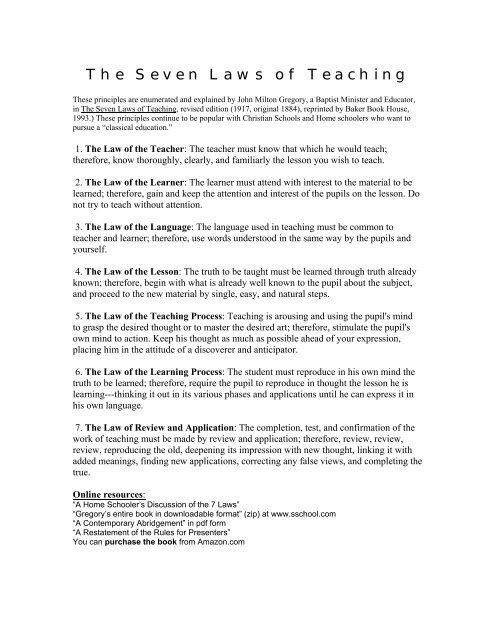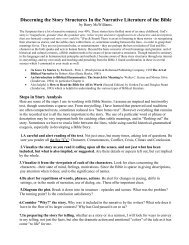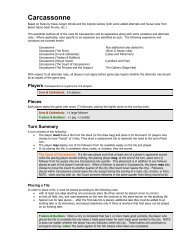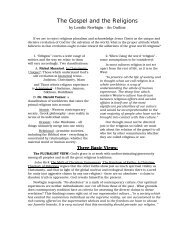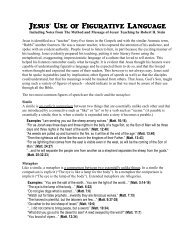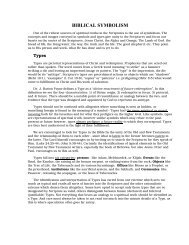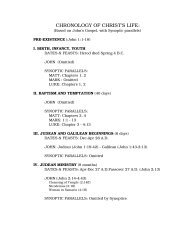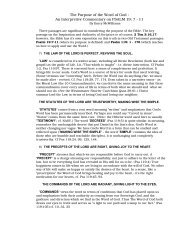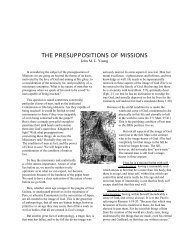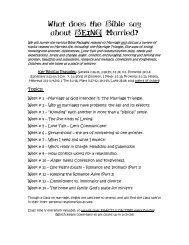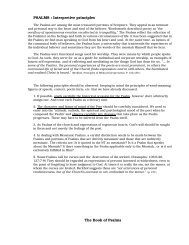The Seven Laws of Teaching - Eldrbarry's Story Telling Page
The Seven Laws of Teaching - Eldrbarry's Story Telling Page
The Seven Laws of Teaching - Eldrbarry's Story Telling Page
You also want an ePaper? Increase the reach of your titles
YUMPU automatically turns print PDFs into web optimized ePapers that Google loves.
<strong>The</strong> <strong>Seven</strong> <strong>Laws</strong> <strong>of</strong> <strong>Teaching</strong><strong>The</strong>se principles are enumerated and explained by John Milton Gregory, a Baptist Minister and Educator,in <strong>The</strong> <strong>Seven</strong> <strong>Laws</strong> <strong>of</strong> <strong>Teaching</strong>, revised edition (1917, original 1884), reprinted by Baker Book House,1993.) <strong>The</strong>se principles continue to be popular with Christian Schools and Home schoolers who want topursue a “classical education.”1. <strong>The</strong> Law <strong>of</strong> the Teacher: <strong>The</strong> teacher must know that which he would teach;therefore, know thoroughly, clearly, and familiarly the lesson you wish to teach.2. <strong>The</strong> Law <strong>of</strong> the Learner: <strong>The</strong> learner must attend with interest to the material to belearned; therefore, gain and keep the attention and interest <strong>of</strong> the pupils on the lesson. Donot try to teach without attention.3. <strong>The</strong> Law <strong>of</strong> the Language: <strong>The</strong> language used in teaching must be common toteacher and learner; therefore, use words understood in the same way by the pupils andyourself.4. <strong>The</strong> Law <strong>of</strong> the Lesson: <strong>The</strong> truth to be taught must be learned through truth alreadyknown; therefore, begin with what is already well known to the pupil about the subject,and proceed to the new material by single, easy, and natural steps.5. <strong>The</strong> Law <strong>of</strong> the <strong>Teaching</strong> Process: <strong>Teaching</strong> is arousing and using the pupil's mindto grasp the desired thought or to master the desired art; therefore, stimulate the pupil'sown mind to action. Keep his thought as much as possible ahead <strong>of</strong> your expression,placing him in the attitude <strong>of</strong> a discoverer and anticipator.6. <strong>The</strong> Law <strong>of</strong> the Learning Process: <strong>The</strong> student must reproduce in his own mind thetruth to be learned; therefore, require the pupil to reproduce in thought the lesson he islearning---thinking it out in its various phases and applications until he can express it inhis own language.7. <strong>The</strong> Law <strong>of</strong> Review and Application: <strong>The</strong> completion, test, and confirmation <strong>of</strong> thework <strong>of</strong> teaching must be made by review and application; therefore, review, review,review, reproducing the old, deepening its impression with new thought, linking it withadded meanings, finding new applications, correcting any false views, and completing thetrue.Online resources:“A Home Schooler’s Discussion <strong>of</strong> the 7 <strong>Laws</strong>”“Gregory’s entire book in downloadable format” (zip) at www.sschool.com“A Contemporary Abridgement” in pdf form“A Restatement <strong>of</strong> the Rules for Presenters”You can purchase the book from Amazon.com
A Shorter Version: In Acrostic Form*T eachers know their stuff*E eager students pay attention*A ble to understand each other*C onnect the known to the unknown*H elp children to find out for themselves*E xpress and explain it*R eview and apply it<strong>Seven</strong> <strong>Laws</strong> to Help You Present Better: An Abridged version1. Know the subjectStudy the material fresh each timeSeek out and use illustrations from real lifeUse a natural order <strong>of</strong> truth, from the simple to the complex2. Generate audience interestGain and keep the attention and interest <strong>of</strong> your audienceUse a variety <strong>of</strong> presentation techniques: visual aids, stories, illustrations, questions anddiscussion Make your presentation interactive by asking questions3. Use words that your audience knowsUse short sentencesExplain new ideas by using objects, visual aids, slides, pictures, analogies and discussion4. Build on known truthsRelate your points and illustrations to what your audience has experiencedHelp your audience understand that practical new knowledge is usable in life experience5. Stimulate self-learningUse practical exercises and illustrations that activate audience members' imaginationsand get them involvedEncourage your audience to try new skills and seek new knowledge. Demystify theunknown6. Learn by doingStimulate audience questioning, answering and participationMake sure your audience's actions are practical. An activity must lead somewhere and gothere for a reason7. Tell them, tell them again, then tell them what you told themRemember that review is the final touch to your presentationRepetition begets retention.
From the Sunday School <strong>Page</strong>:1. <strong>The</strong> Law <strong>of</strong> the Teacher• Teachers must be fully equipped with the knowledge they wish to communicate• Fresh study and preparation are keys to enriched teaching.2. <strong>The</strong> Law <strong>of</strong> the Learner• Student interest and attention must be generated by the teacher.• A teacher's enthusiasm is contagious with students.3. <strong>The</strong> Law <strong>of</strong> the Lesson• Lessons are best begun with common and familiar experiences.• Excellent teachers understand the background <strong>of</strong> their pupils and use it as astarting point.4. <strong>The</strong> Law <strong>of</strong> the Language• <strong>The</strong> words used by teachers must he easily understood by students.• Illustrations, natural objects, and visual aids are important to goodcommunication.5. <strong>The</strong> Law <strong>of</strong> the <strong>Teaching</strong> Process• Expert teachers arouse and direct self-activities by their students, thus stimulatingthem to learn for themselves.• Student skills grow with practical exercises involving their minds.6. <strong>The</strong> Law <strong>of</strong> the Learning Process• Excellent education helps learners to be investigative discoverers.• Real and valuable learning is more than memorization.7. <strong>The</strong> Law <strong>of</strong> Review and Application• Review perfects knowledge, confirms knowledge, arid makes knowledge readyand useful.• Practical reviews are characteristic <strong>of</strong> excellent teachers.Eldrbarry’s Home <strong>Page</strong> (Source Unknown) Barry McWilliamsThis <strong>Page</strong>: http://www.eldrbarry.net/clas/ecem/7laws.pdf


